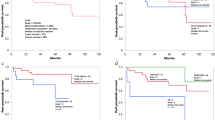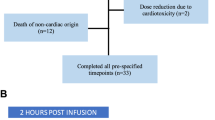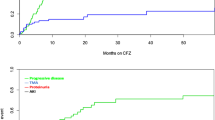Abstract
Peripheral arterial occlusive disease (PAOD) occurs in patients with chronic phase chronic myeloid leukemia (CML-CP) treated with tyrosine kinase inhibitors (TKIs). The risk of developing PAOD on TKI therapy is unknown and causality has not been established. Patients with CML-CP from three randomized phase III studies (IRIS, TOPS and ENESTnd) were divided into three cohorts: no TKI (cohort 1; n=533), nilotinib (cohort 2; n=556) and imatinib (cohort 3; n=1301). Patients with atherosclerotic risk factors were not excluded. Data were queried for terms indicative of PAOD. Overall, 3, 7 and 2 patients in cohorts 1, 2 and 3, respectively, had PAOD; 11/12 patients had baseline PAOD risk factors. Compared with that of cohort 1, exposure-adjusted risks of PAOD for cohorts 2 and 3 were 0.9 (95% CI, 0.2–3.3) and 0.1 (95% CI, 0.0–0.5), respectively. Multivariate logistic regression revealed that nilotinib had no impact on PAOD rates compared with no TKI, whereas imatinib had decreased rates of PAOD compared with no TKI. Nilotinib was associated with higher rates of PAOD versus imatinib. Baseline assessments, preferably within clinical studies, of PAOD and associated risk factors should occur when initiating TKI therapy in CML; patients should receive monitoring and treatment according to the standard of care for these comorbidities.
This is a preview of subscription content, access via your institution
Access options
Subscribe to this journal
Receive 12 print issues and online access
$259.00 per year
only $21.58 per issue
Buy this article
- Purchase on Springer Link
- Instant access to full article PDF
Prices may be subject to local taxes which are calculated during checkout
Similar content being viewed by others
References
Force T, Kolaja KL . Cardiotoxicity of kinase inhibitors: the prediction and translation of preclinical models to clinical outcomes. Nat Rev Drug Discov 2011; 10: 111–126.
Cheng H, Force T . Molecular mechanisms of cardiovascular toxicity of targeted cancer therapeutics. Circ Res 2010; 106: 21–34.
Kappers MH, de Beer VJ, Zhou Z, Danser AH, Sleijfer S, Duncker DJ et al. Sunitinib-induced systemic vasoconstriction in swine is endothelin mediated and does not involve nitric oxide or oxidative stress. Hypertension 2012; 59: 151–157.
Chu TF, Rupnick MA, Kerkela R, Dallabrida SM, Zurakowski D, Nguyen L et al. Cardiotoxicity associated with tyrosine kinase inhibitor sunitinib. Lancet 2007; 370: 2011–2019.
Schmidinger M, Zielinski CC, Vogl UM, Bojic A, Bojic M, Schukro C et al. Cardiac toxicity of sunitinib and sorafenib in patients with metastatic renal cell carcinoma. J Clin Oncol 2008; 26: 5204–5212.
Aichberger KJ, Herndlhofer S, Schernthaner GH, Schillinger M, Mitterbauer-Hohendanner G, Sillaber C et al. Progressive peripheral arterial occlusive disease and other vascular events during nilotinib therapy in CML. Am J Hematol 2011; 86: 533–539.
Tefferi A, Letendre L . Nilotinib treatment-associated peripheral artery disease and sudden death: yet another reason to stick to imatinib as front-line therapy for chronic myelogenous leukemia. Am J Hematol 2011; 86: 610–611.
Le Coutre P, Rea D, Abruzzese E, Dombret H, Trawinska MM, Herndlhofer S et al. Severe peripheral arterial disease during nilotinib therapy. J Natl Cancer Inst 2011; 103: 1347–1348.
Kantarjian HM, Hochhaus A, Saglio G, De Souza C, Flinn IW, Stenke L et al. Nilotinib versus imatinib for the treatment of patients with newly diagnosed chronic phase, Philadelphia chromosome-positive, chronic myeloid leukaemia: 24-month minimum follow-up of the phase 3 randomised ENESTnd trial. Lancet Oncol 2011; 12: 841–851.
Levato L, Cantaffa R, Kropp M, Magro D, Piro E, Molica S . Progressive peripheral arterial occlusive disease and other vascular events during nilotinib therapy in chronic myeloid leukemia. 54th ASH Annual Meeting and Exposition 2012; (abstract 1679—Poster Presentation).
Labussière-Wallet H, Guillermin Y, Etienne M, Barale A, Serrier C, Tigaud I et al. Analysis of clinical arterial and metabolic parameters in chronic phase CML patients on nilotinib in a single center cohort. 54th Annual ASH Annual Meeting and Exposition 2012; (abstract 3756).
Hirsch AT, Criqui MH, Treat-Jacobson D, Regensteiner JG, Creager MA, Olin JW et al. Peripheral arterial disease detection, awareness, and treatment in primary care. JAMA 2001; 286: 1317–1324.
Larson RA, Hochhaus A, Hughes TP, Clark RE, Etienne G, Kim DW et al. Nilotinib vs imatinib in patients with newly diagnosed Philadelphia chromosome-positive chronic myeloid leukemia in chronic phase: ENESTnd 3-year follow-up. Leukemia 2012; 26: 2197–2203.
Hooi JD, Stoffers HEJH, Kester ADM, Rinkens PELM, Kaiser V, van Ree JW et al. Risk factors and cardiovascular diseases associated with asymptomatic peripheral arterial occlusive disease: The Limburg PAOD Study. Scand J Prim Health Care 1998; 16: 177–182.
Hooi JD, Kester ADM, Stoffers HEJH, Overdijk MM, van Ree JW, Knottnerus JA . Incidence of and risk factors for asymptomatic peripheral arterial occlusive disease: a longitudinal study. Am J Epidemiol 2001; 153: 666–672.
Selvin E, Erlinger TP . Prevalence of and risk factors for peripheral arterial disease in the United States: results from the National Health and Nutrition Examination Survey, 1999-2000. Circulation 2004; 110: 738–743.
Alzamora MT, Fores R, Baena-Diez JM, Pera G, Toran P, Sorribes M et al. The peripheral arterial disease study (PERART/ARTPER): prevalence and risk factors in the general population. BMC Public Health 2010; 10: 38.
Olin JW, Sealove BA . Peripheral artery disease: current insight into the disease and its diagnosis and management. Mayo Clin Proc 2010; 85: 678–692.
ICLUSIG (package insert)ARIAD Pharmaceuticals, Inc.: Cambridge, MA, USA 2012.
Schwarz M, Kim TD, Mirault T, Grille P, Rea D, Lindhorst R et al. Elevated risk of peripheral artery occlusive disease (PAOD) in nilotinib treated chronic phase chronic myeloid leukemia (CML) patients assessed by ankle-brachial-index (ABI) and duplex ultrasonography. 54th ASH Annual Meeting and Exposition 2012; (abstract 914).
Saglio G, Kim DW, Issaragrisil S, le Coutre P, Etienne G, Lobo C et al. Nilotinib versus imatinib for newly diagnosed chronic myeloid leukemia. N Engl J Med 2010; 362: 2251–2259.
Cortes JE, Baccarani M, Guilhot F, Druker BJ, Branford S, Kim DW et al. Phase III, randomized, open-label study of daily imatinib mesylate 400 mg versus 800 mg in patients with newly diagnosed, previously untreated chronic myeloid leukemia in chronic phase using molecular end points: tyrosine kinase inhibitor optimization and selectivity study. J Clin Oncol 2010; 28: 424–430.
O'Brien SG, Guilhot F, Larson RA, Gathmann I, Baccarani M, Cervantes F et al. Imatinib compared with interferon and low-dose cytarabine for newly diagnosed chronic-phase chronic myeloid leukemia. N Engl J Med 2003; 348: 994–1004.
Hirsch AT, Haskal ZJ, Hertzer NR, Bakal CW, Creager MA, Halperin JL et al. ACC/AHA 2005 guidelines for the management of patients with peripheral arterial disease (lower extremity, renal, mesenteric, and abdominal aortic): executive summary. A collaborative report from the American Association for Vascular Surgery/Society for Vascular Surgery, Society for Cardiovascular Angiography and Interventions, Society for Vascular Medicine and Biology, Society of Interventional Radiology, and the ACC/AHA Task Force on Practice Guidelines (Writing Committee to Develop Guidelines for the Management of Patients With Peripheral Arterial Disease) endorsed by the American Association of Cardiovascular and Pulmonary Rehabilitation; National Heart, Lung, and Blood Institute; Society for Vascular Nursing; TransAtlantic Inter-Society Consensus; and Vascular Disease Foundation. J Am Coll Cardiol 2006; 47: 1239–1312.
Larson RA, Hochhaus A, Hughes TP, Clark RE, Etienne G, Kim D et al. Nilotinib vs imatinib in patients with newly diagnosed Philadelphia chromosome-positive chronic myeloid leukemia in chronic phase: ENESTnd 3-year follow-up. Leukemia 2012; 26: 2197–2203.
Periard D, Cavassini M, Taffe P, Chevalley M, Senn L, Chapuis-Taillard C et al. High prevalence of peripheral arterial disease in HIV-infected persons. Clin Infect Dis 2008; 46: 761–767.
Franchini M . Thrombotic complications in patients with hereditary bleeding disorders. Thromb Haemost 2004; 92: 298–304.
Agostino NM, Chinchilli VM, Lynch CJ, Koszyk-Szewczyk A, Gingrich R, Sivik J et al. Effect of the tyrosine kinase inhibitors (sunitinib, sorafenib, dasatinib, and imatinib) on blood glucose levels in diabetic and nondiabetic patients in general clinical practice. J Oncol Pharm Pract 2011; 17: 197–202.
Lassila M, Allen TJ, Cao Z, Thallas V, Jandeleit-Dahm KA, Candido R et al. Imatinib attenuates diabetes-associated atherosclerosis. Arterioscler Thromb Vasc Biol 2004; 24: 935–942.
Hatano M, Yao A, Shiga T, Kinugawa K, Hirata Y, Nagai R . Imatinib mesylate has the potential to exert its efficacy by down-regulating the plasma concentration of platelet-derived growth factor in patients with pulmonary arterial hypertension. Int Heart J 2010; 51: 272–276.
Masuda S, Nakano K, Funakoshi K, Zhao G, Meng W, Kimura S et al. Imatinib mesylate-incorporated nanoparticle-eluting stent attenuates in-stent neointimal formation in porcine coronary arteries. J Atheroscler Thromb 2011; 18: 1043–1053.
Nakamura K, Akagi S, Ogawa A, Kusano KF, Matsubara H, Miura D et al. Pro-apoptotic effects of imatinib on PDGF-stimulated pulmonary artery smooth muscle cells from patients with idiopathic pulmonary arterial hypertension. Int J Cardiol 2011; 159: 100–106.
Li L, Blumenthal DK, Masaki T, Terry CM, Cheung AK . Differential effects of imatinib on PDGF-induced proliferation and PDGF receptor signaling in human arterial and venous smooth muscle cells. J Cell Biochem 2006; 99: 1553–1563.
Manley PW, Drueckes P, Fendrich G, Furet P, Liebetanz J, Martiny-Baron G et al. Extended kinase profile and properties of the protein kinase inhibitor nilotinib. Biochim Biophys Acta 2010; 1804: 445–453.
Franco C, Ahmad PJ, Hou G, Wong E, Bendeck MP . Increased cell and matrix accumulation during atherogenesis in mice with vessel wall-specific deletion of discoidin domain receptor 1. Circ Res 2010; 106: 1775–1783.
Ahmad PJ, Trcka D, Xue S, Franco C, Speer MY, Giachelli CM et al. Discoidin domain receptor-1 deficiency attenuates atherosclerotic calcification and smooth muscle cell-mediated mineralization. Am J Pathol 2009; 175: 2686–2696.
Franco C, Britto K, Wong E, Hou G, Zhu SN, Chen M et al. Discoidin domain receptor 1 on bone marrow-derived cells promotes macrophage accumulation during atherogenesis. Circ Res 2009; 105: 1141–1148.
Franco C, Hou G, Ahmad PJ, Fu EY, Koh L, Vogel WF et al. Discoidin domain receptor 1 (ddr1) deletion decreases atherosclerosis by accelerating matrix accumulation and reducing inflammation in low-density lipoprotein receptor-deficient mice. Circ Res 2008; 102: 1202–1211.
Marchioli R, Finazzi G, Landolfi R, Kutti J, Gisslinger H, Patrono C et al. Vascular and neoplastic risk in a large cohort of patients with polycythemia vera. J Clin Oncol 2005; 23: 2224–2232.
Kantarjian HM, Kim D-, Issaragrilsil S, Clark RE, Reiffers J, Nicolini FE et al. ENESTnd 4-year update: continued superiority of nilotinib versus imatinib in patients with newly diagnosed Philadelphia chromosome–positive (Ph+) chronic myeloid leukemia in chronic phase. 54th ASH Annual Meeting and Exposition 2012; (abstract 1676).
Kim TD, Rea D, Schwarz M, Grille P, Nicolini FE, Rosti G et al. Peripheral artery occlusive disease (PAOD) in chronic phase chronic myeloid leukemia patients treated with nilotinib or imatinib. Leukemia 2013; e-pub ahead of print 5 March 2013 doi:10.1038/leu.2013.70.
Acknowledgements
Financial support for medical editorial assistance was provided by Novartis Pharmaceuticals. The authors thank Michael Mandola, PhD, for medical editorial assistance with this manuscript.
Author information
Authors and Affiliations
Corresponding author
Ethics declarations
Competing interests
FJG, MJM, PDLC, AH, and GS have consulted for, and received research funding from, Novartis. FH, C-EO, CM, and RCW are Novartis employees and stockholders.
Rights and permissions
About this article
Cite this article
Giles, F., Mauro, M., Hong, F. et al. Rates of peripheral arterial occlusive disease in patients with chronic myeloid leukemia in the chronic phase treated with imatinib, nilotinib, or non-tyrosine kinase therapy: a retrospective cohort analysis. Leukemia 27, 1310–1315 (2013). https://doi.org/10.1038/leu.2013.69
Received:
Accepted:
Published:
Issue Date:
DOI: https://doi.org/10.1038/leu.2013.69
Keywords
This article is cited by
-
BCR/ABL-Positive Chronic Myeloid Leukemia in Children: Current Treatment Approach
Current Oncology Reports (2024)
-
Adverse effects of tyrosine kinase inhibitors in cancer therapy: pathophysiology, mechanisms and clinical management
Signal Transduction and Targeted Therapy (2023)
-
Cardiovascular Adverse Events of Tyrosine Kinase Inhibitors in Chronic Myeloid Leukemia: Clinical Relevance, Impact on Outcome, Preventive Measures and Treatment Strategies
Current Treatment Options in Oncology (2023)
-
Guidelines for the treatment of chronic myeloid leukemia from the NCCN and ELN: differences and similarities
International Journal of Hematology (2023)
-
Cardiovascular Toxicities Associated with Tyrosine Kinase Inhibitors
Current Cardiology Reports (2023)



